中西方饮食文化差异与中餐菜单的英译
中西饮食文化中英文
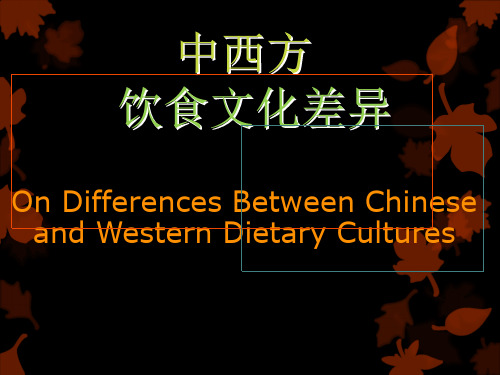
Key point
From here, a brief talk about the following four areas in the Western diet and cultural differences. 1 2 3 4
Two kind of different diet idea
China and West diet object’s difference
Western pay more attention to the nutrition reasonable collocation(合理的营养搭配), therefore their country„s person body is generally(通常) more vigorous( adj. 有 力的;精力充沛的) and healthier than the Chinese.
In China, people sat together, sharing a meal. Banquet with round table, this is creating a form from unity, manners, and were fun atmosphere(气氛). People drink a toast dishes for each other, in the good things in front, embodies体现 the mutual respect, and comity between people of virtue.
LOGO
Key point
From here, a brief talk about the following four areas in the Western diet and cultural differences. 1 2 3 4
中美饮食文化差异英文版加翻译
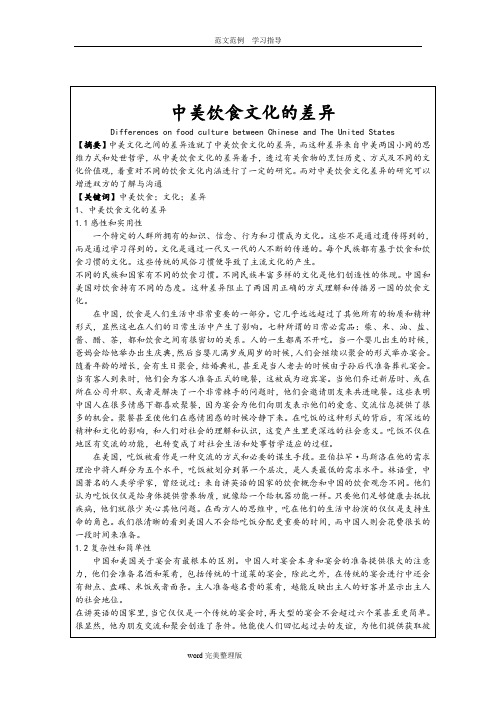
IThe Differences on Food Culture BetweenChinaand the U.S
1.1Sensibility vs. practicality
Culture is defined as the knowledge, beliefs, customs, and habits a group of people share. These are not inherited behaviors, but learned. Culture is passed on from generation to generation. Each ethnic group has1ts own culturally based foods and food habits. These traditions have been influenced and adapted through contact with the mainstream culture (Luo12).
与中国相比与中国相比与中国相比讲英语国家的食物是很简单的讲英语国家的食物是很简单的讲英语国家的食物是很简单的缺乏一种漂亮的气氛缺乏一种漂亮的气氛缺乏一种漂亮的气氛而且而且而且他们的烹饪技术和中国的相比是低等的他们的烹饪技术和中国的相比是低等的他们的烹饪技术和中国的相比是低等的许多美国事物的分支是从其他国家引进的许多美国事物的分支是从其他国家引进的许多美国事物的分支是从其他国家引进的但是从食但是从食但是从食物的营养价值来判断物的营养价值来判断物的营养价值来判断讲英语的国家的食物讲究营养讲英语的国家的食物讲究营养讲英语的国家的食物讲究营养并且试图让食物低盐同时维持各种营养并且试图让食物低盐同时维持各种营养并且试图让食物低盐同时维持各种营养的平衡
中西方饮食文化差异(英文)
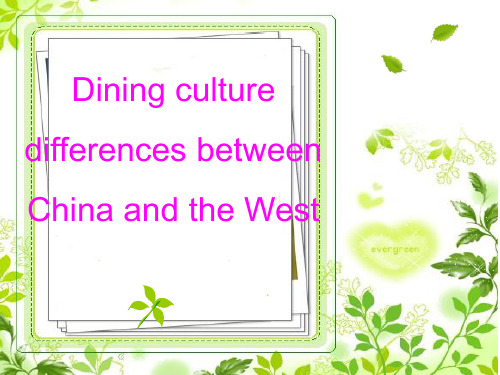
Comparison of Chinese and Western table manners
.
Chinese table manners
The general etiquette on the table
➢➢AKveoeidp cyoouugr hfeineg.t uandesrnyeoeuzrinsgeaotn,atanbdleb.aIcfkyosutraight. c➢anK’eet p quiet with mouth full ➢hTealpblceowuagrheinfogr, yreomureomwbnershtoousladyn"ostobrrey.p" ut in the ➢ Tphuebleicvepnlattoef. accidents, such as wine, water, soup ➢sTpolatsahkeedfoinotdo socthoeorps’soucplo,thyoeus,syhoouucldanusaepologize.
developed muscles
there are relatively well-developed food industries, such as canned food, fast food and so on,although taste is monotonous, but to save time, and the well-nourished
Dietary differences in the way
➢ When the chinese go to a restarant,however, they ask for a small room with plain walls where they cannot be seen except by the members of their own party, where jackets can come off and they can proceed with the serious business which brought them there.The chinese intentions are both honourable and whole-hearted.
西方餐饮及其文化中英文
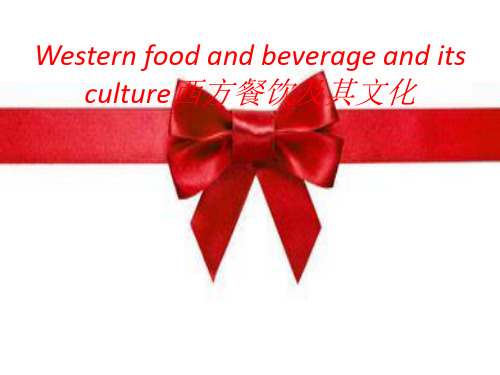
⑥How to eat bread 怎样正确的吃面包
• The brபைடு நூலகம்ad is torn to pieces.
面包要手撕成小块来吃
• The dish to eat bread with a small piece of bread and gently put meat or vegetables to eat on the fork, don't use a knife to push.
前菜(開胃菜)→ 湯+麵包 → 沙 拉 → 副 菜 → 主 菜 →甜點→飲料
⑤The use of knives and forks 刀叉的使用
On the way to the toilet or meal, after the meal, how to put the knife and fork
夹菜吃面包时用一小块面包轻轻地把肉 块或菜蔬推到叉子上食用,别用刀来 推。
创作者 LL
Thank you for listening.
感谢您的聆听。
Ending结束
( Westerners eat sweets, the Chinese people to the main.西方人多吃甜食,中国人以咸 为主。)
• 4. Food environment is different 饮食环境不 同
( Westerners pay attention to delicate, Chinese pay attention to ostentation.西方人注重精致, 中国人注重排场。)
中西餐菜单的区别 英语介绍
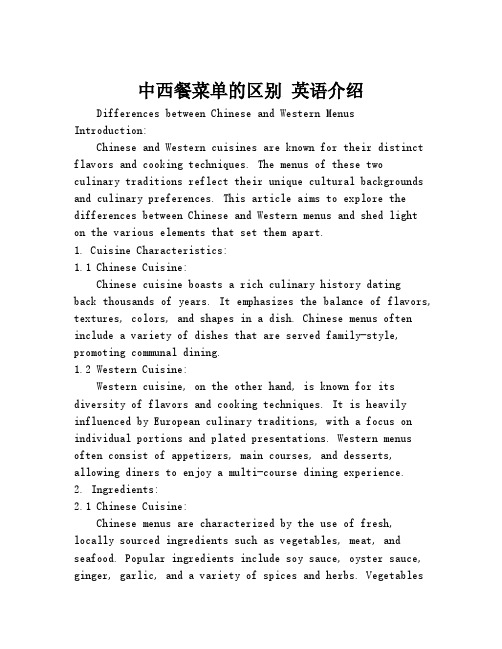
中西餐菜单的区别英语介绍Differences between Chinese and Western Menus Introduction:Chinese and Western cuisines are known for their distinct flavors and cooking techniques. The menus of these twoculinary traditions reflect their unique cultural backgrounds and culinary preferences. This article aims to explore the differences between Chinese and Western menus and shed light on the various elements that set them apart.1. Cuisine Characteristics:1.1 Chinese Cuisine:Chinese cuisine boasts a rich culinary history datingback thousands of years. It emphasizes the balance of flavors, textures, colors, and shapes in a dish. Chinese menus often include a variety of dishes that are served family-style, promoting communal dining.1.2 Western Cuisine:Western cuisine, on the other hand, is known for its diversity of flavors and cooking techniques. It is heavily influenced by European culinary traditions, with a focus on individual portions and plated presentations. Western menus often consist of appetizers, main courses, and desserts, allowing diners to enjoy a multi-course dining experience.2. Ingredients:2.1 Chinese Cuisine:Chinese menus are characterized by the use of fresh,locally sourced ingredients such as vegetables, meat, and seafood. Popular ingredients include soy sauce, oyster sauce, ginger, garlic, and a variety of spices and herbs. Vegetablesplay a significant role in Chinese cuisine, providing a wide range of flavors and textures.2.2 Western Cuisine:Western menus often feature ingredients like beef, pork, chicken, fish, and a variety of vegetables and grains. Dairy products, such as cheese and butter, are also commonly used. Western cuisines make use of herbs and spices such as thyme, rosemary, and basil to enhance the flavors of a dish.3. Cooking Techniques:3.1 Chinese Cuisine:Chinese cooking techniques include stir-frying, steaming, boiling, braising, and deep-frying. Stir-frying is a popular technique that quickly cooks ingredients over high heat while retaining their textures and flavors. Steaming is another common technique used in Chinese cuisine, preserving the natural taste and nutrients of the ingredients.3.2 Western Cuisine:Western cooking techniques vary depending on the region and culinary tradition. Techniques such as grilling, roasting, baking, and sautéing are commonly employed. Grilling impartsa smoky flavor to meats and vegetables, while roasting and baking use dry heat in an oven to cook ingredients. Sautéing involves quickly frying ingredients in a small amount of oilor butter over high heat.4. Menu Structure:4.1 Chinese Cuisine:Chinese menus often offer a wide range of dishes, categorized into various sections such as appetizers, soups, meat dishes, vegetable dishes, and rice or noodle dishes. These dishes are meant to be shared among diners, creating a communal dining atmosphere.4.2 Western Cuisine:In contrast, Western menus typically follow a structured format. They begin with appetizers, followed by main courses, and conclude with desserts. Each course offers a distinct set of dishes, allowing diners to savor a variety of flavors and textures throughout the meal.Conclusion:In conclusion, Chinese and Western menus differ in cuisine characteristics, ingredients, cooking techniques, and menu structures. Chinese menus focus on the balance offlavors and communal dining experience, while Western menus emphasize individual portions and a multi-course dining experience. Understanding these differences allows diners to appreciate the unique aspects of each culinary tradition and broaden their gastronomic horizons.。
中西饮食文化对比 英文

夫妻肺片 Pork Lungs in Chili Sauce
麻婆豆腐
Mapo Tofu (Stir-Fried Tofu in Hot Sauce)
四 川 火 锅
Sichuan Hot pot
浙菜
浙菜浙江素有粮仓的美誉,土地肥沃,山丘连绵, 物产丰饶,饮食历史灿烂悠久,浙菜是全国8大菜 系之一,它的风味包括杭州、宁波,温州、金华等 地方的菜点特色。鲜嫩软滑,香醇绵糯,清爽不腻。 以浙江菜系各地风味佳肴,流行于华人地区。品种 丰富,菜式小巧玲珑,菜品鲜美滑嫩、脆软清爽, 其特点是清、香、脆、嫩、爽、鲜,在中国众多的 地方风味中占有重要的地位。浙菜就整体而言,有 比较明显的特色风格,又具有共同的四个特点:选 料讲究,烹饪独到,注重原味。制作精细。许多堪 称旷世之作,以风土人情、风情雅韵来命名,造型 优美。许多菜肴都富有哲理的美丽诉说,文化色彩 浓郁是浙江美食一大特色。
臭鳜鱼(腌鲜鳜鱼)
红烧果子狸 Stewed civet cats
粤菜
粤菜即广东菜,由广府、客家、潮汕三种风 味组成,在中国大部分地区都有粤菜馆。在 国内、海外影响极大。所以,也有不少人, 特别是广东人认为粤菜乃八大菜系之首。不 仅香港、澳门,而且世界各国的中菜馆,多 数是以粤菜为主。粤菜是国内民间第二大菜 系,地位仅次于川菜。在国外是中国的代表 菜系。粤菜以广府风味为代表。
Eight Culinary Traditions of China 八大菜系
Hui Cantonese Min Hunan Su Lu chuan Zhe
徽菜 粤菜 闽菜 湘菜 苏菜 鲁菜 川菜 浙菜
徽菜
▪ 徽菜 即徽州菜系,不等同与安徽菜。 徽菜主要流行于徽州地区和浙江西部。和江苏菜系 中的苏南菜、浙江菜系较近。 徽州主要有两百多个品种,风味主要特点是:擅长 烧、炖,讲究火功,很少爆、炒,并习以火腿佐味, 冰糖提鲜,善于保持原汁原味。不少菜肴都是用木 炭火单炖、单火靠,原锅上桌,不仅体现了徽古朴 典雅的风格,而且香气四溢,诱人食欲。
中西餐桌文化差异英文简短
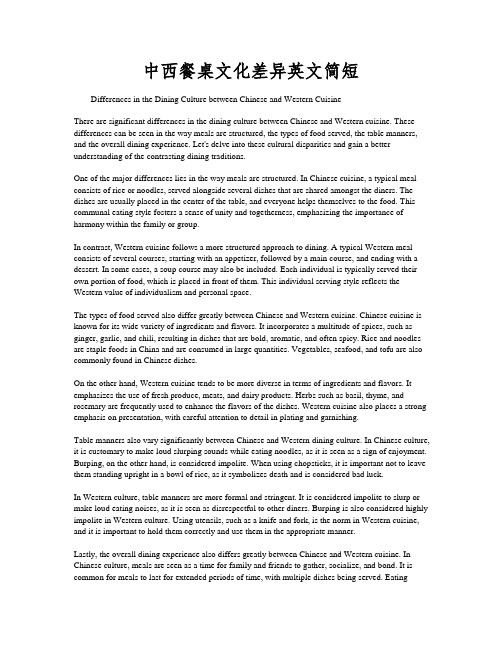
中西餐桌文化差异英文简短Differences in the Dining Culture between Chinese and Western CuisineThere are significant differences in the dining culture between Chinese and Western cuisine. These differences can be seen in the way meals are structured, the types of food served, the table manners, and the overall dining experience. Let's delve into these cultural disparities and gain a better understanding of the contrasting dining traditions.One of the major differences lies in the way meals are structured. In Chinese cuisine, a typical meal consists of rice or noodles, served alongside several dishes that are shared amongst the diners. The dishes are usually placed in the center of the table, and everyone helps themselves to the food. This communal eating style fosters a sense of unity and togetherness, emphasizing the importance of harmony within the family or group.In contrast, Western cuisine follows a more structured approach to dining. A typical Western meal consists of several courses, starting with an appetizer, followed by a main course, and ending with a dessert. In some cases, a soup course may also be included. Each individual is typically served their own portion of food, which is placed in front of them. This individual serving style reflects the Western value of individualism and personal space.The types of food served also differ greatly between Chinese and Western cuisine. Chinese cuisine is known for its wide variety of ingredients and flavors. It incorporates a multitude of spices, such as ginger, garlic, and chili, resulting in dishes that are bold, aromatic, and often spicy. Rice and noodles are staple foods in China and are consumed in large quantities. Vegetables, seafood, and tofu are also commonly found in Chinese dishes.On the other hand, Western cuisine tends to be more diverse in terms of ingredients and flavors. It emphasizes the use of fresh produce, meats, and dairy products. Herbs such as basil, thyme, and rosemary are frequently used to enhance the flavors of the dishes. Western cuisine also places a strong emphasis on presentation, with careful attention to detail in plating and garnishing.Table manners also vary significantly between Chinese and Western dining culture. In Chinese culture, it is customary to make loud slurping sounds while eating noodles, as it is seen as a sign of enjoyment. Burping, on the other hand, is considered impolite. When using chopsticks, it is important not to leave them standing upright in a bowl of rice, as it symbolizes death and is considered bad luck.In Western culture, table manners are more formal and stringent. It is considered impolite to slurp or make loud eating noises, as it is seen as disrespectful to other diners. Burping is also considered highly impolite in Western culture. Using utensils, such as a knife and fork, is the norm in Western cuisine, and it is important to hold them correctly and use them in the appropriate manner.Lastly, the overall dining experience also differs greatly between Chinese and Western cuisine. In Chinese culture, meals are seen as a time for family and friends to gather, socialize, and bond. It is common for meals to last for extended periods of time, with multiple dishes being served. Eatingtogether is a way to strengthen relationships and foster camaraderie.In Western culture, meals are often viewed as a more functional activity. It is common for individuals to eat alone or grab a quick meal on the go. Meals tend to be shorter in duration, with a focus on efficiency. However, in certain Western cultures, such as in France or Italy, dining experiences can be more leisurely and extravagant, resembling the Chinese approach to dining.In conclusion, the dining culture between Chinese and Western cuisine exhibits significant disparities. These differences can be observed in the way meals are structured, the types of food served, the table manners, and the overall dining experience. Though these cultural disparities may seem vast, they serve as a testament to the rich diversity and uniqueness of the culinary traditions around the world.。
中西菜单的差异与翻译

因此
,
在 对中餐菜单进 烹调方
,
、
以 吉利
,
喜庆 的 名 称 寓
。
ru
“
乡
a nd o
、
s e r
0 5
、
th a t
th 即 m 即 b e p
”
,
译 者 除 了 掌 握每 道 菜 的原 料
。
配 以菜 品 用 料 及 做 法
么 中
、
体现 在 菜 单 之 中
。
是
烘干
烤干
一
焙干
一
s u链 从制作 过程看 a
,
饮 食 结 构 的差 异
文 化 差异
,
为中餐菜单英
,
[ ] 何燕 萍 3
.
.
中餐菜名 英译及 其对外 汉语教
,
化 各 不 相 同 不 同 的饮 食承 载 着 丰 富 的 民俗 风情
中西 菜 单 无 论 是 在 编 排 上还 是在 内 容 上 着 较 大 的差 异 性
、 、
,
译 带 来 了 较 多 的困 难 和 阻碍
社科研究
1N S I H T G
中西 菜 单 的差异 与 翻 译
文
_
戴铭
摘要 惯
,
:
中餐 菜 单 的英 译 首先 要 遵循 英 语 语 言 的 习
,
的 民俗情趣 以及 地 方 风 l i l t
e
ho t
u t b e
r
r o o t h e
u
r
~
刚
) 意识
,
还 要 对 中西 菜 单 中 的 差 异 有 所 把 握
,
采
中西饮食文化差异与中餐菜单的英译
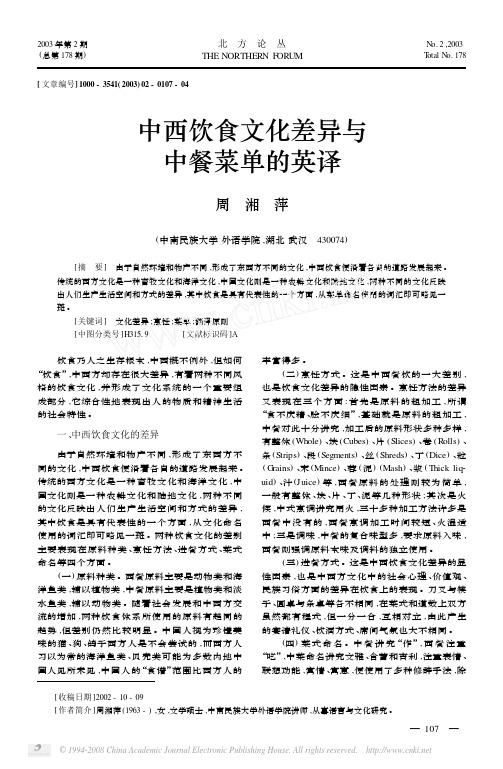
[文章编号]1000-3541(2003)02-0107-04[收稿日期]2002-10-09[作者简介]周湘萍(1963-),女,文学硕士,中南民族大学外语学院讲师,从事语言与文化研究。
中西饮食文化差异与中餐菜单的英译周 湘 萍(中南民族大学外语学院,湖北武汉 430074)[摘 要] 由于自然环境和物产不同,形成了东西方不同的文化,中西饮食便沿着各自的道路发展起来。
传统的西方文化是一种畜牧文化和海洋文化,中国文化则是一种农耕文化和陆地文化,两种不同的文化反映出人们生产生活空间和方式的差异,其中饮食是具有代表性的一个方面,从菜单命名使用的词汇即可略见一斑。
[关键词] 文化差异;烹饪;菜单;翻译原则[中图分类号]H31519 [文献标识码]A 饮食乃人之生存根本,中西概不例外,但如何“饮食”,中西方却存在很大差异,有着两种不同风格的饮食文化,并形成了文化系统的一个重要组成部分,它综合性地表现出人的物质和精神生活的社会特性。
一、中西饮食文化的差异由于自然环境和物产不同,形成了东西方不同的文化,中西饮食便沿着各自的道路发展起来。
传统的西方文化是一种畜牧文化和海洋文化,中国文化则是一种农耕文化和陆地文化,两种不同的文化反映出人们生产生活空间和方式的差异,其中饮食是具有代表性的一个方面,从文化命名使用的词汇即可略见一斑。
两种饮食文化的差别主要表现在原料种类、烹饪方法、进餐方式、菜式命名等四个方面。
(一)原料种类。
西餐原料主要是动物类和海洋鱼类,辅以植物类,中餐原料主要是植物类和淡水鱼类,辅以动物类。
随着社会发展和中西方交流的增加,两种饮食体系所使用的原料有趋同的趋势,但差别仍然比较明显。
中国人视为珍馐美味的猫、狗、鸽子西方人是不会尝试的,而西方人习以为常的海洋鱼类、贝壳类可能为多数内地中国人见所未见,中国人的“食谱”范围比西方人的丰富得多。
(二)烹饪方式。
这是中西餐饮的一大差别,也是饮食文化差异的隐性因素。
中西饮食文化差异及中西菜肴翻译方法
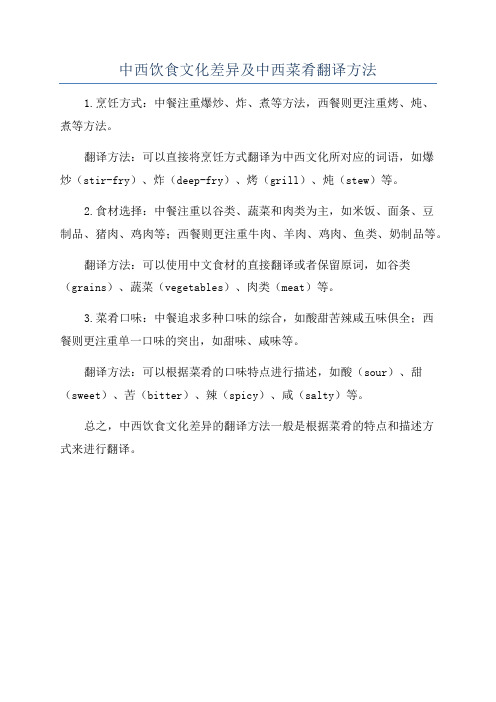
中西饮食文化差异及中西菜肴翻译方法
1.烹饪方式:中餐注重爆炒、炸、煮等方法,西餐则更注重烤、炖、
煮等方法。
翻译方法:可以直接将烹饪方式翻译为中西文化所对应的词语,如爆
炒(stir-fry)、炸(deep-fry)、烤(grill)、炖(stew)等。
2.食材选择:中餐注重以谷类、蔬菜和肉类为主,如米饭、面条、豆
制品、猪肉、鸡肉等;西餐则更注重牛肉、羊肉、鸡肉、鱼类、奶制品等。
翻译方法:可以使用中文食材的直接翻译或者保留原词,如谷类(grains)、蔬菜(vegetables)、肉类(meat)等。
3.菜肴口味:中餐追求多种口味的综合,如酸甜苦辣咸五味俱全;西
餐则更注重单一口味的突出,如甜味、咸味等。
翻译方法:可以根据菜肴的口味特点进行描述,如酸(sour)、甜(sweet)、苦(bitter)、辣(spicy)、咸(salty)等。
总之,中西饮食文化差异的翻译方法一般是根据菜肴的特点和描述方
式来进行翻译。
中西方饮食文化差异(英文)

Cultural differences between Chinese and Western food
1.Because of the differences in geographical features, climate of the environment, customs and other factors, food products will appear different degrees of differences in the raw materials, taste, cooking methods, eating habits.
spulabslhicepdlainteto. others’ clothes, you can apologize. ThTeorteakisenfoondeescdotopbseopuapn, iyco. u should use cInhothpestcicakssepoufbthlice kmeay.ster himself cooking food, do noNtefovergredtigtoteaeptphrewciitahteyothuer foinwgneersr., apply a tooWthhpiliecke,ating, you’d better not smoke.You should aasnkdfocroyvoeurrwniethighhabnodr’sorphearmndiskseiorcnhiifeyf.ou have to.
developed muscles
there are relatively well-developed food industries, such as canned food, fast food and so on,although taste is monotonous, but to save time, and the well-nourished
中西方饮食文化差异(中英对照)

Differences between Chinese and Western diet culture Can you imagine the difference between the Western diet culture and the Chinese diet culture?First of all, I will introduce the general characteristics of Western diet culture. Western diet historyItaly cuisine is the originator of the Western diet culture, French cuisine is the Western diet culture king, American food is the Western diet culture upstart.Western food making skillsIn the production of the Western diet, they love the pursuit of perfection, but also attach importance to cooperation with a delicacy.Western diet varietiesThe famous dishes are Italy, French, American, German, Russian, etc. famous drinks include wine, coffee and black tea.Do you know,why there are so many differences between Chinese and Western diet culture ?just like the menu,western diet is very tidy and serious,but the Chinese is multifarious.Now, you have known the difference of the menu,but do you know why diet has a strong regional character?Actually, western diet due to geographical characteristics, environment, customs, appears in cooking methods ofdifferences in eating habits. People in western countries like to eat pizza, while Chinese people like to eat dumplings.Differences between Chinese and Western culture makes a difference of Chinese and Western food culture.事实上,西方饮食由于地域特色、环境、风俗习惯,出现烹调方法不同程度的差异。
中、西餐菜单的差异与翻译
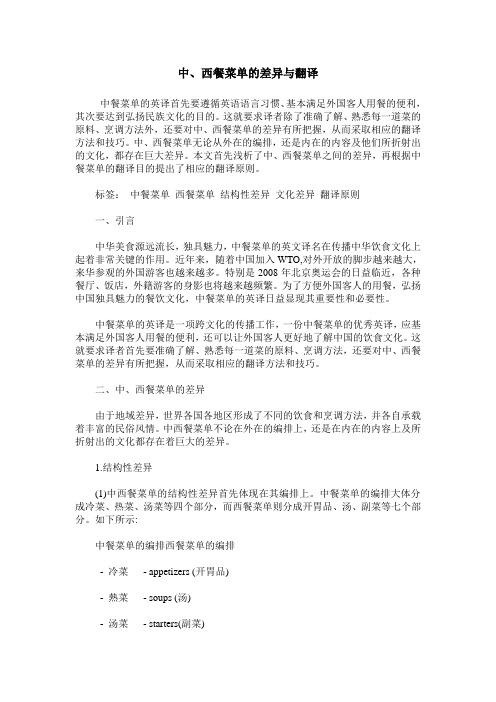
中、西餐菜单的差异与翻译中餐菜单的英译首先要遵循英语语言习惯、基本满足外国客人用餐的便利,其次要达到弘扬民族文化的目的。
这就要求译者除了准确了解、熟悉每一道菜的原料、烹调方法外,还要对中、西餐菜单的差异有所把握,从而采取相应的翻译方法和技巧。
中、西餐菜单无论从外在的编排,还是内在的内容及他们所折射出的文化,都存在巨大差异。
本文首先浅析了中、西餐菜单之间的差异,再根据中餐菜单的翻译目的提出了相应的翻译原则。
标签:中餐菜单西餐菜单结构性差异文化差异翻译原则一、引言中华美食源远流长,独具魅力,中餐菜单的英文译名在传播中华饮食文化上起着非常关键的作用。
近年来,随着中国加入WTO,对外开放的脚步越来越大,来华参观的外国游客也越来越多。
特别是2008年北京奥运会的日益临近,各种餐厅、饭店,外籍游客的身影也将越来越频繁。
为了方便外国客人的用餐,弘扬中国独具魅力的餐饮文化,中餐菜单的英译日益显现其重要性和必要性。
中餐菜单的英译是一项跨文化的传播工作,一份中餐菜单的优秀英译,应基本满足外国客人用餐的便利,还可以让外国客人更好地了解中国的饮食文化。
这就要求译者首先要准确了解、熟悉每一道菜的原料、烹调方法,还要对中、西餐菜单的差异有所把握,从而采取相应的翻译方法和技巧。
二、中、西餐菜单的差异由于地域差异,世界各国各地区形成了不同的饮食和烹调方法,并各自承载着丰富的民俗风情。
中西餐菜单不论在外在的编排上,还是在内在的内容上及所折射出的文化都存在着巨大的差异。
1.结构性差异(1)中西餐菜单的结构性差异首先体现在其编排上。
中餐菜单的编排大体分成冷菜、热菜、汤菜等四个部分,而西餐菜单则分成开胃品、汤、副菜等七个部分。
如下所示:中餐菜单的编排西餐菜单的编排- 冷菜- appetizers (开胃品)- 熱菜- soups (汤)- 汤菜- starters(副菜)- 主食和小吃- main courses (主菜)- salads (蔬菜类菜肴)- desserts (甜点)- coffee, tea (咖啡、茶)(2)其次,中西餐菜单的结构性差异还体现在烹调方法的繁复程度上。
中西方饮食文化与中餐菜单的翻译.pdf

中西方饮食文化与中餐菜单的翻译摘要由于地理环境的不同,各国文化发展的不同,中国和西方在饮食文化上差别也很大,主要表现在饮食结构、食物制作和营养保健方面。
为此应该充分认识到中西饮食文化的差异,准备翻译中餐菜单,这样才能更好的融合中西方的文化,促进文化的良好交流和发展。
关键词:饮食文化中餐餐单翻译差别The Western diet culture and the translation of Chinese menu AbstractDue to the geographical environment of the different cultures of different countries, different development, China and the West in the diet culture differences, mainly in the diet, food production and nutrition health care aspect. This should be fully aware of the differences between Chinese and Western food culture, preparation of translation of Chinese menu, so as to better integration of Chinese and Western culture, promoting cultural exchanges and the development of the good.Key words:Diet culture Chinese food Menu translation difference目录1 中国的饮食文化 (1)2 西方的饮食文化 (1)3 中餐菜单翻译的方法 (2)3.1 写实性命名的菜谱的翻译 (2)3.1.1 菜名以主料开头的菜单 (2)3.1.2 菜名以烹制方法开头的菜单 (3)3.1.3 菜名以形状或口感开头的菜单: (3)3.1.4 菜名以人名或地名开头的菜单 (3)3.2 写意性命名的菜名的翻译 (3)3.3 菜单翻译中应注意的文化冲突 (4)4 结论 (5)参考文献 (5)1 中国的饮食文化中国饮食文化的历史源远流长,博大精深。
中西方饮食文化(英文)
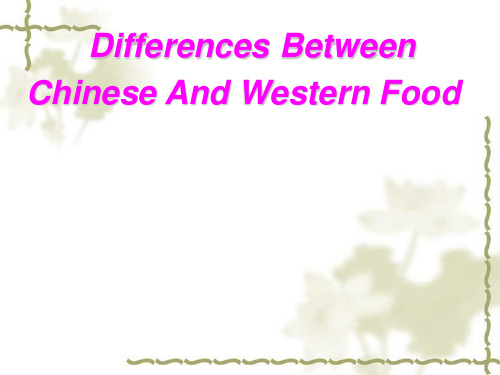
wide choice of materials
bird’s nest (燕窝)
three meals a day in the West and chinese
Western Breakfast
bread , milk, eggs, coffee
Sausage, potatoes, (香肠) fruit cereals (麦片)
❖ calories vitamins, (热量) protein And so on. (蛋白质)
In China
Bread is the staff of life food to taste first 民以食为天 食以味为先
Cபைடு நூலகம்lor, flavor,taste
鲁 苏 闽
China's eight major
Chinese food
pork
pork
ﻼWe eat 600 kinds of vegetables
six times more than in the West
ﻼWe are truly vegetarin (素食主义者)
Western food
❖a large piece of meat
The concept of two different diets
Objects of Chinese and Western food Three meals a day in the West and China
In west
rational eating
(理性饮食)
nutrition
❖ monotonous, bland
❖whole chickens
中西方饮食差异 英文版
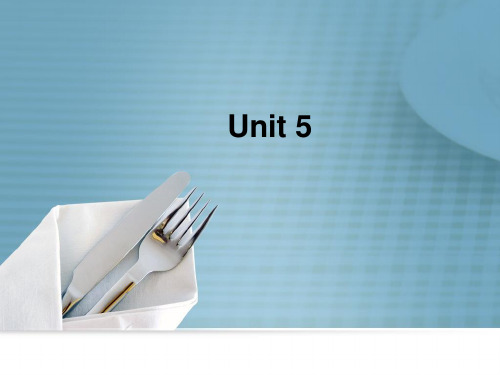
accepting a reservation
W: This is … restaurant, what can I do for you?/May I help you? G: I’d like to reserve a table tonight. W: How many people are in your part? G: three W: At what time would do you like? G: Six o’clock W: May I have you name, please. G: David. W: Thank you. I have reserve a table for three at six o’clock tonight in the name of David. G: Thank you. W: Thank you for calling us. Bye
Great Traditions (八大菜系):
• Anhui(安徽菜), Cantonese(广东菜), Fujian(福建菜), Hunan(湖南菜), Jiangsu(江苏菜), Shandong(山东菜), Sichuan(四川菜), and Zhejiang(浙江菜).
Anhui cuisine
ii. not yet have booked • • • • • • W: Good evening, Sir. What can I help you? How many people are in your party G: I want a table for 3 W: Come this way, please. G: Could we take this table W: I am sorry, but this table have been already reserved. How about that table?
中西方饮食文化差异与中餐菜单的英译

中西方饮食文化差异与中餐菜单的英译(总11页)-CAL-FENGHAI.-(YICAI)-Company One1-CAL-本页仅作为文档封面,使用请直接删除中西方饮食文化差异与中餐菜单的英译摘要:由于地域、政治、经济、技术等诸多因素的影响,中西方文化呈现出风格迥异的姿态,同时,中西方文化的差异也造就了中西方饮食文化的差异。
地域特征、气候环境、民俗风情等条件都潜移默化地左右着中西方饮食文化的发展,使其在原料选取、口味偏好、烹调方式、饮食习惯等方面呈现不同程度的差异。
本文着眼于中西方饮食文化在饮食观念、饮食内容、烹饪方式、进餐方式、菜单命名等方面的差异,分析中西菜单翻译面临的问题与瓶颈,提炼出更为精准适宜的翻译原则与翻译方法,使中国菜单更科学合理地被西方友人理解接受。
关键词:饮食文化;文化差异;中餐菜名;翻译手法一脉相承、历久弥新的中国饮食文化是中华文明的重要组成部分,它不仅与人们日常生活息息相关,也是博大精深中华文化的载体。
随着国家博物馆对外交流活动的不断增加,国博餐厅成为展示中国饮食文化的首要窗口。
长期以来,许多到中国畅游的外国游客都以能享受到正宗地道的中国美食为主要目的,中餐已成为中外文化交流的重要媒介。
合理准确的菜名翻译不仅可以使国外友人正确理解菜单所要传达的信息,而且还能使中华美食在他们心中留下美好印象,进一步促进中华饮食文化传播。
然而,由于中西方的饮食文化存在巨大的差异,中餐菜单的英译会产生一些问题。
为了更好地向西方用餐人士传播中国饮食文化,如何更精准传神地翻译中餐菜单,避免不必要的误解便成为亟需解决的问题。
因此,只有熟悉中西方饮食文化的差异,了解中式菜肴的内涵,灵活运用相应的翻译方法,才能使外国客人更好地了解中国的饮食文化。
一、中西方饮食文化的差异饮食文化是人类不断开拓食源和制造食品的各生产领域和从饮食实践中展开的各种社会生活,以及反映这二者的多种意识形态的总称。
(林乃焱:《中国古代饮食文化》)饮食文化也是一种广谱文化,反映着人类生存与发展现状,是一种日常可见可闻的身边文化。
- 1、下载文档前请自行甄别文档内容的完整性,平台不提供额外的编辑、内容补充、找答案等附加服务。
- 2、"仅部分预览"的文档,不可在线预览部分如存在完整性等问题,可反馈申请退款(可完整预览的文档不适用该条件!)。
- 3、如文档侵犯您的权益,请联系客服反馈,我们会尽快为您处理(人工客服工作时间:9:00-18:30)。
中西方饮食文化差异与中餐菜单的英译摘要:由于地域、政治、经济、技术等诸多因素的影响,中西方文化呈现出风格迥异的姿态,同时,中西方文化的差异也造就了中西方饮食文化的差异。
地域特征、气候环境、民俗风情等条件都潜移默化地左右着中西方饮食文化的发展,使其在原料选取、口味偏好、烹调方式、饮食习惯等方面呈现不同程度的差异。
本文着眼于中西方饮食文化在饮食观念、饮食内容、烹饪方式、进餐方式、菜单命名等方面的差异,分析中西菜单翻译面临的问题与瓶颈,提炼出更为精准适宜的翻译原则与翻译方法,使中国菜单更科学合理地被西方友人理解接受。
关键词:饮食文化;文化差异;中餐菜名;翻译手法一脉相承、历久弥新的中国饮食文化是中华文明的重要组成部分,它不仅与人们日常生活息息相关,也是博大精深中华文化的载体。
随着国家博物馆对外交流活动的不断增加,国博餐厅成为展示中国饮食文化的首要窗口。
长期以来,许多到中国畅游的外国游客都以能享受到正宗地道的中国美食为主要目的,中餐已成为中外文化交流的重要媒介。
合理准确的菜名翻译不仅可以使国外友人正确理解菜单所要传达的信息,而且还能使中华美食在他们心中留下美好印象,进一步促进中华饮食文化传播。
然而,由于中西方的饮食文化存在巨大的差异,中餐菜单的英译会产生一些问题。
为了更好地向西方用餐人士传播中国饮食文化,如何更精准传神地翻译中餐菜单,避免不必要的误解便成为亟需解决的问题。
因此,只有熟悉中西方饮食文化的差异,了解中式菜肴的内涵,灵活运用相应的翻译方法,才能使外国客人更好地了解中国的饮食文化。
一、中西方饮食文化的差异饮食文化是人类不断开拓食源和制造食品的各生产领域和从饮食实践中展开的各种社会生活,以及反映这二者的多种意识形态的总称。
(林乃焱:《中国古代饮食文化》)饮食文化也是一种广谱文化,反映着人类生存与发展现状,是一种日常可见可闻的身边文化。
中西方文化的差异衍生出不同的饮食文化,使其具有浓郁的地域性和民族性。
比较中西方饮食文化的差异以及探究这些差异所产生的内在渊源,有助于从理论和实践两个方面来研究中餐菜单的英译问题,从而使西方友人更便捷直接地理解并接受中餐菜名。
首先,本文主要从饮食观念、饮食内容、烹饪方式、进餐方式和菜式命名等几个方面浅释中西两种饮食文化的差异。
(一)饮食观念不同西方的饮食观念偏重理性与科学,他们在意每餐食物的营养价值,力求通过一日三餐摄取足够的蛋白质、脂肪、热量和维生素,讲究各种营养搭配科学合宜,能量供给恰到好处。
而对于食物的色、香、味、形则退居其次。
相比而言,中国人在饮食上追求的是味感美学,是视觉、味觉、触觉三者调和圆融的“意境”,而对食物的营养搭配不太讲究。
同时,繁缛的烹调方法也加速了食物营养的流失,使得中餐的营养价值稍打折扣。
(二)饮食内容不同西方人的饮食以荤食为主,喜爱使用牛肉、鸡肉、猪肉、羊肉和鱼等作为主料,蔬菜则作为辅料出现。
这与西方人游牧民族,航海民族的文化特点紧密相连。
而中国受农本经济的影响,在饮食内容方面,以五谷为主食,辅之以蔬菜和少量肉食,植物类菜品在饮食结构中占着主导地位。
据植物学家调查,中国人吃的蔬菜有600多种,比西方多6倍。
(三)烹饪方式的不同这是中西餐饮的一大差别,也是饮食文化差异的隐形因素。
烹饪方法的差异又表现在三个方面:首先是原料的粗加工,所谓“食不厌精、脍不厌细”,基础就是原料的粗加工。
西餐原料的处理则较为简单,一般有整体(whole)、块(cubes)、片(slices)、丁(dices)、泥(mash)等几种形状;中餐对此十分讲究,加工后的原料除有与西餐相同的几种形状外,还有卷(rolls)、条(strips)、段(segments)、丝(shreds)、粒(grains)、末(mince)、浆(thick liquid)、汁(juice)等。
中餐的烹饪方法也比西餐形式更复杂,有煮(boiling)、煲/炖(stewing)、烧/焖/烩(braising)、煎(frying)、炒(stir-frying)、炸(deep-frying)、煨(simmering)、熏(smoking)、蒸(steaming)、白灼(scalding)等。
其次是火候,西餐烹调火温适中,中式烹调特别讲究火候,火候到味道好。
三是调味,中餐的复合味型多,要求原料入味,西餐则强调原料本味及调料的独立使用。
(四)进餐方式《礼记?礼运》言:“夫礼之初,始者饮食。
”中国人用餐喜欢热闹,人们团团围坐、相互敬酒、夹菜,营造出人与人之间活跃热情。
中国人一起用餐,避讳只顾自己埋头苦吃,不能融入集体。
而西方人用餐时讲究情调,他们注重自己的言谈举止,喝酒或咀嚼食物时都不发出声音,互相之间干杯也点到为止,席间宾客很少大声喧哗。
主人很少给客人夹菜,通常由客人自主食用。
西方人在用餐时虽也围桌而坐,但是他们习惯分餐制,以自助餐为典型,个人的食物都是单盘独碟盛放。
(五)菜式命名中式菜肴命名讲究文雅、含蓄和吉利,注重寓意,使用多种修辞手法,除少量大众化菜肴以原料直接命名外,相当一部分菜是以创始人、典故和传闻来命名的,这种命名方法的缺点是菜名与原料无明显关联,往往不知所云,如“佛跳墙”等。
西式菜肴命名则直截了当,突出原料,极少使用类似中餐命名的修辞手段,虽少了艺术性,但多了实用性。
当然,西式菜肴命名也讲究高雅,但表现方法则是以法文命名。
“When we talk of meat on our table we use French words,when we speak of the animals from which the meat comes we use Anglo-Saxon words. It is a pig in its sty,it is pork (pore)on the table. There are cattle in the fields,but we sit down to beef (boeuf). Chickens become poulty(poulet),and a calf becomes veal (veau). Even if our menus were not written in French out of snobbery,the English we used in them would still be Norman English.”《大学英语:高级英语,P28》这是由于罗曼人曾经征服英国,英国农民在牧养牲畜时,讲的是盎格鲁-撒克逊英语,而这些牲畜被端到餐桌上给法国统治者享用时,就有了法语名称,相沿成习,它变成了一种?{雅。
二、中餐菜单英译原则由于中西方饮食文化客观存在的差异性和中国菜肴本身的文化韵味,要把中餐菜单中的菜名从中文翻译成英文,并非只是语言层次上的浅显转化,也是文化层次上的进一步转化。
中餐菜单的服务对象是外国客人,所以翻译时,应认真考虑他们对英译菜单的要求和喜好,设法克服因中西方饮食文化差异给翻译带来的不利影响,为外国客人的就餐提供尽可能多的方便。
从而使中华美食在外国客人心中留下美好的印象。
因此,在英译中餐菜单时,应该注意以下三种原则。
(一)通俗易懂,确保准确达意要解决中餐菜单的英译问题,首先应明确中餐菜单的语篇类型及功能。
中餐菜单作为一个完整而独立的语篇,是“信息类语篇”。
因为,通常情况下,菜单只是一系列可供选择的菜名方面的信息。
从语篇功能方面看,英译的中餐菜单是“传递信息”的,其预期译文功能是让外国客人用餐时,能够看懂菜单上的菜名,了解这些美味佳肴是用什么原料做的,方便他们的用餐。
这也是英译中餐菜单的目的之一。
(二)典雅规范,弘扬中华文化英译中餐菜单时,还要达到弘扬民族文化的目的。
“译者在对汉语原文及其文化理解透彻的同时,还要对英语运用自如,并对英语国家的文化和风俗习惯有一个全面的了解。
”(冯庆华:《实用翻译教程》)因此,翻译中餐菜单时,应遵循英语语言习惯,参照西餐菜单的特点,让外国客人了解菜单中所包含的文化层次的表层现象,如:原料、烹饪方法、特点等内容。
(三)兼顾文化,避免文化冲突中餐菜名为了吉祥,借用一些不能食用的物品或西方人忌讳食用的动物名。
曾经看到过这样一个故事:有位华人来到新西兰,雄心勃勃地开了一家中餐馆。
谁料想开业还没到三天,餐馆就被抗议者围了个水泄不通。
究其原因,竟然是老板将其中的一道菜“红烧狮子头”直接翻译成了“red burnt lion head”。
当地的动物保护组织无法容忍中国人竟然公开叫卖狮子头。
最后老板只有公开道歉并予以澄清,并把菜名改为了“braised pork ball with brown sauce”。
这个故事听起来令人啼笑皆非。
它反映出中国餐饮业要走向世界首先要解决的问题就是菜名的准确翻译。
因此,菜名的英译要避免文化冲突,跨越中西方语言和文化上的双重障碍。
三、中餐菜单的英译方法通过对英译中餐菜单应该遵循的原则的分析,我们理解了翻译时,既要保留中式菜肴中原有的文化韵味,准确得传递和反映菜肴内容和特色,还要考虑的菜单的特点,顺从外国客人的文化习惯与接受能力。
鉴于中餐菜单英译的特点,我们灵活地采用不同的翻译方法。
由于参与了国博餐厅中餐厅和自助餐厅的菜单翻译工作,结合实践经验,我认为中餐菜单的英译方法大体可归纳为以下四种:直译法、意译法、音译法及几种方法并用的翻译法。
(一)直译法直译法,顾名思义就是按照中文菜名译出其意。
对于能够从中国菜的菜名中可以直接了解到菜肴的原料、刀法、烹制方法、口感、配料、配汁等内容的,可以采用直译法。
例如:a.烹调法+原料清蒸桂鱼:steamed mandarin fishb.烹调法+主料+with+配料(in+配料)红烧肉:braised pork in brown saucec.口味+主料(+配料)糖醋排骨:sweet and sour spareribsd.主料+配料+器皿铁板蒜子黄鳝:spiced eels with garlic on iron boarde.人名/地名+烹饪方法+原料北京烤鸭:Beijing roast duck(二)意译法中式菜肴中,有些菜名讲究文雅,往往不直接以菜的原料命名,也不能全面、完整地反映菜肴的具体风格。
有些菜名中,用一些代表吉祥如意的词来表达人们对美好生活的向往和祝愿。
在翻译这些菜名时,要避虚就实,用意译将主配料和烹饪方式等译出。
如:翡翠虾仁:fried shelled shrimp with green vegetable,“翡翠”是指青菜。
鱼香肉丝:shredded pork with garlic sauce,“鱼香”在餐桌上并非指“鱼”,而是指辣味的“蒜酱”。
咕?K肉:sweet and sour pork,“咕?K”实际上是指“糖醋”。
